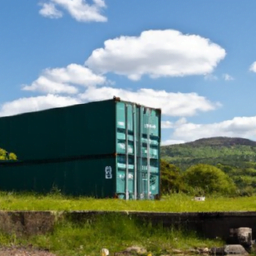I explore the question of whether it is permissible to place a shipping container on agricultural land in the United Kingdom. This inquiry emerges from the growing interest in off-grid living and the desire to utilize unconventional structures to fulfill practical needs. By examining the legal and regulatory framework surrounding land usage, I aim to provide a comprehensive understanding of the potential implications and possibilities involved in placing shipping containers on agricultural land in the UK. By considering factors such as planning permission, environmental impact, and agricultural guidelines, we can better assess the feasibility and legality of this intriguing endeavor.
Can I Put A Shipping Container On Agricultural Land UK?
Laws and Regulations
As an academic researcher exploring the topic of placing shipping containers on agricultural land in the UK, it is essential to examine the laws and regulations surrounding this practice. The legal aspect of this issue is governed primarily by the Town and Country Planning Act 1990. Under this act, certain types of development are classified as “permitted development” and do not require planning permission. However, it is crucial to consider specific regulations that may be in place at the local level.
Planning Permission
To determine whether planning permission is required to place a shipping container on agricultural land, it is necessary to assess the specific circumstances and contexts in which the land is classified and designated. Generally, land without any specific use or allocated zoning may allow for temporary structures like shipping containers as long as they meet legal requirements and adhere to certain restrictions. However, obtaining confirmation from local planning authorities is advisable to ensure compliance.
Temporary or Permanent Structure
When contemplating the placement of a shipping container on agricultural land in the UK, distinguishing between temporary and permanent structures is crucial. Temporary structures may be more easily permitted under certain conditions, such as a limited timeframe for placement and clear plans for removal. Permanent structures, on the other hand, may necessitate additional scrutiny and compliance with building regulations to ensure structural integrity, safety, and adherence to environmental standards.
Environmental Considerations
The environmental impact of placing shipping containers on agricultural land in the UK must be thoroughly assessed. While some may argue that repurposing shipping containers aligns with sustainability principles by promoting reuse, there are several factors to consider. These considerations include the potential for soil contamination, impact on local ecosystems, drainage and runoff management, and the conservation of natural resources. Adhering to established environmental guidelines and ensuring proper waste management practices are crucial.
Access and Infrastructure
Before placing a shipping container on agricultural land, it is important to assess the accessibility and infrastructure requirements. Agricultural activities often necessitate regular access for vehicles and machinery. Therefore, it is essential to evaluate whether the location and placement of the shipping container may impede access or pose logistical challenges. Additionally, considering the availability of services such as water, electricity, and waste disposal is vital to ensure the compatibility of the container with existing infrastructure.
Design and Structural Requirements
When considering the placement of a shipping container on agricultural land in the UK, it is essential to evaluate the design and structural requirements. As these containers were originally intended for transportation rather than habitation, modifications may be necessary to ensure they meet applicable building regulations and structural integrity standards. Reinforcement, insulation, ventilation, and fire safety measures are just a few considerations that should be addressed to ensure the container’s suitability for agricultural purposes.
Repurposing and Modifications
Repurposing a shipping container for agricultural use may offer a practical solution to various needs on agricultural land. However, it is essential to evaluate the modifications required to adapt the container for this purpose. Ventilation, lighting, and insulation may need to be added to create a suitable environment for storing equipment, livestock, or farm produce. Additionally, considering the long-term maintenance and durability of the modified container is crucial for ensuring its viability and cost-effectiveness.
Land Use and Tenure
The use and tenure of agricultural land play a significant role when contemplating the placement of a shipping container. The primary purpose of agricultural land is generally for farming activities, and any additional structures should align with this objective. It is important to consider whether the container placement may impede or restrict agricultural activities or have implications for land use in the long term. Additionally, the ownership or tenancy agreements for the land should be thoroughly assessed to ensure compliance and avoid any legal conflicts.
Insurance
One aspect that should not be overlooked is the necessity of appropriate insurance coverage when placing a shipping container on agricultural land. Insurance policies should adequately protect the container, its contents, and any liabilities associated with its placement. Assessing the risk factors specific to the location and the potential impact on neighboring properties is essential. Engaging with insurance providers experienced in agricultural and temporary structure coverage is advisable to ensure comprehensive protection.
Financial Considerations
It is crucial to consider the financial implications of placing a shipping container on agricultural land in the UK. Apart from any initial costs associated with container purchase or modifications, ongoing maintenance, and repair expenses should be factored in. Additionally, understanding any potential impact on property value, rental income, or tax assessments is essential. Conducting a thorough cost-benefit analysis, including long-term projections, is advisable to make informed financial decisions when considering the placement of a shipping container on agricultural land in the UK.
In conclusion, the placement of shipping containers on agricultural land in the UK requires careful consideration of various factors, including legal requirements, environmental impact, structural integrity, land use restrictions, and financial implications. By thoroughly assessing these aspects and seeking appropriate advice and permissions from local authorities, individuals can make informed decisions regarding the use of shipping containers in agricultural settings. Keeping in mind the importance of sustainability, safety, and compatibility with existing infrastructure and activities is vital for ensuring a harmonious integration of shipping containers on agricultural land in the UK.




